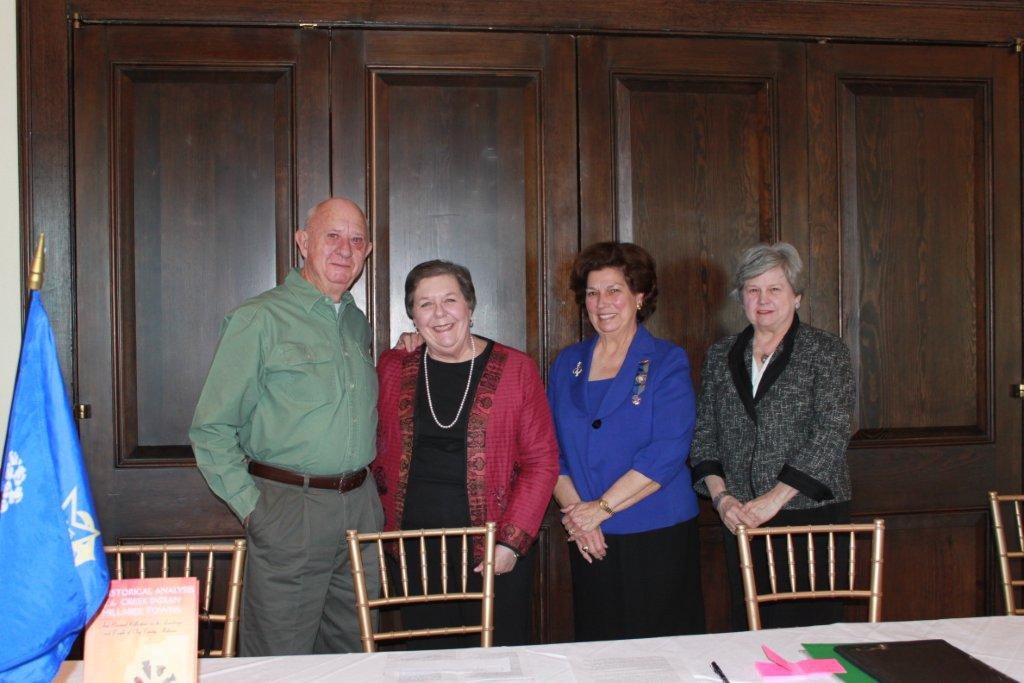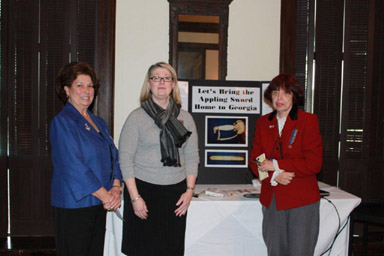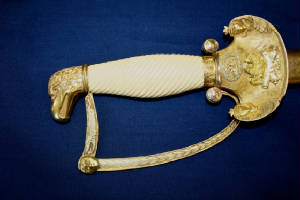
|
ALABAMA STATE SOCIETY USD 1812
|
January 19, 2012: Program-The Creek War. Speaker Captain Don C. East

L to R: Speaker Don C. East, Judith Arthur, Carolyn Drennen, and Gail Pugh
Photo by Rita Reid, Chapter Historian and PR Chairman
Captain Don C. East was born in Elias (Cleveland’s Cross Roads) in Clay County. He graduated from Bibb Graves High School in 1957. He served over 35 years of active duty in the United States Navy as both enlisted and officer, retiring in 1992. During his naval service, he served in numerous foreign countries including Russia, Turkey, Spain, Italy, Germany, Greece and Norway. His sea duty was primarily aboard aircraft carriers. He was involved in flight operations as a Naval Flight Officer, serving in and commanding two electronic reconnaissance squadrons. His education includes undergraduate degrees in engineering science and international relations. His post-graduate work led to masters degrees in international relations and in national security affairs. He is a Russian and Middle East specialist. He is also a graduate of both the Navy and the Air Force War Colleges. He retired to his home area, and lives on Lake Wedowee, where he is the owner and operator of The Creeks Tree Farms in Clay and Randolph Counties. He is also a part-time writer of history and nature articles for local magazines and newspapers. His latest writings are in the form of a book entitled “A Historical Analysis of the Creek Indian Hillabee Towns.” For more information GO TO LINK ON THIS PAGE Under Bibliography.
October 18, 2011- Speaker Susan Lemensis, Past President of the Georgia Society of U.S. Daughters of 1812 and Director of the Daniel Sword Project

Photo by Rita Reid
Shown L to R: Chapter Pres. Carolyn Drennen, Susan Lemensis, and Linda Shabo (1st. Vice)
Daniel Appling is known as Georgia's most prominent soldier in the War of 1812. His reputation stems from an action at the Battle of Sandy Creek on Lake Ontario in upstate New York in 1814. There Appling's command of around 130 riflemen and a similar number of Oneida Indians ambushed and force of 200 British marines and prevented them from seizing naval stores and guns that the American navy was moving by boat to Sackets Harbor. He later distinguished himself in the Battle for Plattsburgh, New York. He was born in 1787 in Columbia County and died in 1817. Current research indicates that he died in Georgia on March 5, 1817 He had resigned his commission, ten months earlier, on June 01, 1816, three months after he returned to Fort Mitchell near present day Phoenix City, Alabama where he was granted a furlough which released him from military duties and allowed him to return home..
The place and time of Appling's death has become part of a much repeated mythology invented during the first years of the twentieth century that has Appling dying at Fort Montgomery in Alabama or at what is now Montgomery Alabama. Interested researchers are encouraged to examine the court papers of Daniel Appling's sister Rebecca who inherited his estate in Columbia County, Georgia and unsuccessfully pushed a prize claim for Appling and his men that was ultimately rejected by the U.S. Congress.

May 19, 2011 Topic: "Remember the Raisin," Battle fought in Michigan on Jan 23, 1813 Video on the River Raisin Click. Site of new National Park Also See
The River Raisin Battlefield was the site of one of largest engagements during the War of 1812. The battle on January 22, and the massacre on January 23, 1813 was fought here in Monroe Michigan (formally Frenchtown) on the northern shore of the River Raisin. Of 934 Americans who fought here, only 33 escaped death or capture. The massacre of wounded soldiers the following day shocked and enraged Americans throughout the Old Northwest Territory and "Remember The Raisin" became the battle cry for the War of 1812.
AWARDS PRESENTED TO ALABAMA SOCIETY AT ASSOCIATE COUNCIL
FEBRUARY 2011
Outstanding Contributions to Chapter History First Place category 4
Alabama Charter Chapter Alabama State Society
Preservation of St. Michael’s and All Angels Church
Individual Donation Recognition To Carole Thomas
Alabama Charter Chapter Alabama State Society
Preservation of St. Michael’s and All Angels Church
Individual Donation Recognition To Connie Grund
Alabama Charter Chapter Alabama State Society
Preservation of St. Michael’s and All Angels Church
Individual Donation Recognition Carolyn Drennen
Alabama Charter Chapter Alabama State Society
Preservation of St. Michael’s and All Angels Church
Individual Donation Recognition Libby Clay
Alabama Charter Chapter Alabama State Society
Outstanding Contributions to Fort McHenry 2nd Place
Alabama Society
Outstanding Contributions to The Star Spangled Banner Flag
House Museum-First Place Category 4 Alabama State Society
Outstanding Contributions to Written Report on Public Relations-
Second Place Rita Reid State PR Chairman, Alabama Charter Chapter
Outstanding Contributions to On-Line Data Base First Place Category 4
Alabama State Society
Outstanding Contributions to Veterans Rehabilitation First Place Category 4
(Stamps for the Wounded 13 lbs) Alabama State Society
Outstanding Rehabilitation –Second Place Category 4
(Most Manufacturer’s Coupons Mailed Overseas-244 lbs. totaling $200,000)
Alabama State Society
Outstanding Contributions Schools Category 4
Alabama State Society
Outstanding Contributions Category 4 Alabama Society
Preservation of St. Michael’s and All Angels Church Second Place
Outstanding Contribution Category 4 First Place
Membership Growth
Outstanding Contributions to National Defense Category 4
Second Place Alabama State Society
Outstanding Contributions to
Books Donated to the National Society, U.S.D. of 1812, First Place
Category 4
Thelma Jackson Hartman, Major Uriah Blue
For Outstanding Contributions to
Newspaper Donation to the 1812 Era Newspaper Collection
January 20, 2011 Meeting
Speaker: Robert Scott Davis, the Director of theFamily
and Regional History Program at
Wallace State College, Hanceville, Alabama who spoke on the War of
1812 and provided our
members with a List of War of 1812 Research Sources.
The October 13 Meeting
Featured Connie H. Grund who reported on trip to Devon, England
Dartmoor Prison and Saint Michael and All Angels Church where
she and Charlotte Slinkard (Past Present of U.S.Daughters of 1812)
visited the American War of 1812 Cemetery, church and prison and
presented the First Sprit of 1812 medal awarded by the
U.S. Daughters of 1812 to Ron Joy.
As prison historian Ron Joy lovingly and patiently preserved
the record of the American prisoners of war who were
imprisoned at Dartmoor during the War of 1812 and
participated in the construction of Saint Michael's Church.
The Spirit of 1812 Award, beginning with this firat,
shall be awarded to an individual or to an
organization with a distinguished record of study, promotion and
dedication to the preservation
of the history of people, places and events of the War of 1812.
January 20, 2011 Meeting
Speaker: Robert Scott Davis, the Director of theFamily
and Regional History Program at
Wallace State College, Hanceville, Alabama who spoke on the War of
1812 and provided our
members with a List of War of 1812 Research Sources.
The October 13 Meeting
Featured Connie H. Grund who reported on trip to Devon, England
Dartmoor Prison and Saint Michael and All Angels Church where
she and Charlotte Slinkard (Past Present of U.S.Daughters of 1812)
visited the American War of 1812 Cemetery, church and prison and
presented the First Sprit of 1812 medal awarded by the
U.S. Daughters of 1812 to Ron Joy.
As prison historian Ron Joy lovingly and patiently preserved
the record of the American prisoners of war who were
imprisoned at Dartmoor during the War of 1812 and
participated in the construction of Saint Michael's Church.
The Spirit of 1812 Award, beginning with this firat,
shall be awarded to an individual or to an
organization with a distinguished record of study, promotion and
dedication to the preservation
of the history of people, places and events of the War of 1812.
The May 20th.Meeting
at the Birmingham Country Club
Featured Davis Arthur, a Fifth Grade Student from Vestavia
Davis is the U.S. Daughters of 1812 First Place Winner

Davis read his award-winning essay at our meeting.
His Topic was: The Creek War, A War of 1812 Civil War Which Transformed
America.
A copy of his speech is available under Chapter Programs
At this meeting we heard reports from members who
attended the U.S.Daughters Associate Council Meeting, April 8-11,
in Washington, D.C. and viewed Photos of this meeting and the Dedication
of graves in the Congressional Cemetery in Washington of our 1812
founder Flora Darling and of Chief Pushmata, the Choctaw leader
whom Andrew Jackson himself described "as our most loyal Indian
ally." Expect to see some of these on this web site soon.
PROGRAM FOR JANUARY 21 MEETING
The Battle of New Orleans
Song the Battle of New Orleans presents a idealized version of this battle:
In 1814 we took a little trip
Along with Colonel Jackson down the mighty Mississip.
We took a little bacon and we took a little beans
And we caught the bloody British in the town of New Orleans.
[Chorus:]
We fired our guns and the British kept a'comin.
There wasn't nigh as many as there was a while ago.
We fired once more and they began to runnin' on
Down the Mississippi to the Gulf of Mexico.
We looked down the river and we see'd the British come.
And there must have been a hundred of'em beatin' on the drum.
They stepped so high and they made the bugles ring.
We stood by our cotton bales and didn't say a thing.
[Chorus]
Old Hickory said we could take 'em by surprise
If we didn't fire our muskets 'til we looked 'em in the eye
We held our fire 'til we see'd their faces well.
Then we opened up with squirrel guns and really gave 'em ... well
[Chorus]
Yeah, they ran through the briars and they ran through the brambles
And they ran through the bushes where a rabbit couldn't go.
They ran so fast that the hounds couldn't catch 'em
Down the Mississippi to the Gulf of Mexico.**
We fired our cannon 'til the barrel melted down.
So we grabbed an alligator and we fought another round.
We filled his head with cannon balls, and powdered his behind
And when we touched the powder off, the gator lost his mind.
[Chorus]
Yeah, they ran through the briars and they ran through the brambles
And they ran through the bushes where a rabbit couldn't go.
They ran so fast that the hounds couldn't catch 'em
Down the Mississippi to the Gulf of Mexico.**
Our October Program on Thursday, October 29th.
Speaker Kathryn Penton (left) shown with Chapter President Carolyn Drennen
Kathryn Madison Penton
spoke on the archaelological dig at Montpelier,
the home of President James Madison and his wife Dollie.
Ms. Penton is a descendant of William Madison, brother of James Madison.